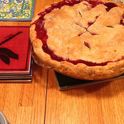My bread won't rise the second time around... And it's hurting me on so many levels.. And #2: how do you actually tell when dough has doubled
Twice now, I have made Smitten Kitchens whole grain cinnamon swirl bread, and twice it is hard and dense. The first time, I think I had not such great yeast because it didn't really rise so well, maybe it didn't double at all. ? The second one, I a bought fresh 1lb bag of Saf-yeast and the first rise was amazing, but now I'm thinking maybe too much?? I think I don't know how to tell when the dough is doubled.
Also - I have the cuisanart steam oven and so my 2nd proof is in there with 100 degree steam.
14 Comments
http://thesolitarycook.wordpress.com/2014/01/26/sunday-baking-gold-nugget-bread/
SAF yeasts (there are several) have been developed to be quite fast-rising; thus the reason they are the yeasts of choice for professional bakers. That said, whole grain breads require a higher level patience in the rising department. Simply because a recipe suggests permitting it to rise for an hour or until doubled, doesn't mean that there is anything magical about the one hour. Too, between the first and second proofing you really don't need to aggressively re-knead your bread. If you've already sufficiently kneaded it once, then allowed it to create lots of lovely carbon dioxide during its first rise, why require it to do it all over again? The second rise will go significantly faster if you gently turn your dough out onto a floured surface, divide it, shape it, then set it to proof again without completely de-gassing it. Most importantly, persevere!
One more time though.. should I toss the remaining dough or give re-kneading it a try?
xo





